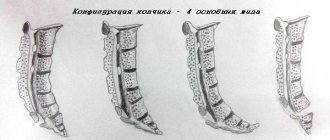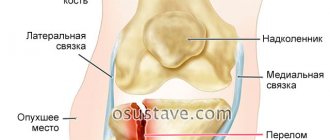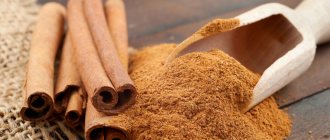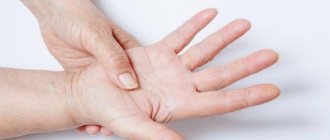From this article you will learn: what is hygroma of the wrist, the theories of its occurrence. Symptoms, diagnostic features, is treatment possible without surgery, prognosis for recovery.
Author of the article: Victoria Stoyanova, category 2 doctor, head of the laboratory at the diagnostic and treatment center (2015–2016).
Article publication date: 05/21/2019
Article updated date: November 28, 2019
Hygroma of the wrist joint (wrist) is a benign neoplasm; it is a cyst in the connective tissue membrane, filled with serous fluid (clear protein fluid). Hygroma is usually located under the skin, next to a joint or tendon sheath (sheath), in the area of the most active movement of the hand.
Injuries, monotonous flexion-extension, rotation, intense work gradually stretch the ligaments, weaken the wrist joint, and lead to wear and thinning of the synovial capsule. This promotes the appearance of a tumor.
Several theories of the development of hygroma, according to which it is considered:
- A protrusion of the synovial membrane of a joint or tendon, which over time is pinched, forming an isolated cyst. This occurs at the site of scarring of connective tissue damaged as a result of the inflammatory process.
- A hernia that occurs against the background of autoimmune processes that stimulate the production of large amounts of synovial fluid. Its growing tension “pushes” the capsule wall outward.
- A cyst formed by modified connective tissue cells that begin to divide uncontrollably, forming a tumor outside the capsule of the joint or tendon.
The compaction that appears as a result of these processes in most cases does not hurt and never metastasizes (does not appear in other organs), but the cells forming its capsule are changed and dividing intensively, which leads to relapse of the disease if the tissue is not completely removed.
Wrist hygroma is not life-threatening, but in 85% of cases it does not respond well to conservative treatment. The only effective method that can completely get rid of the pathology is surgical removal of the tumor.
If you suspect a hygroma of the wrist, you should consult a surgeon, traumatologist or orthopedist. Sometimes a consultation with an oncologist is necessary.
Causes and risk factors
The causes of hand hygroma are not fully understood. It is assumed that the main causes of the development of the disease are:
- genetic predisposition causing weakness of connective tissue structures;
- inflammatory processes in the synovial membrane of the joint capsule or tendon;
- endocrine pathologies;
- surgical interventions;
- single or repeated hand injuries;
- constant high load on the tendon or joint.
At risk of developing hand hygroma are seamstresses, tennis players, pianists, as well as people whose occupation is computer-related.
Conservative therapy
If hygroma of the wrist, hand, or fingers was detected at the initial stage of formation, the attending physician prescribes a set of physiotherapeutic procedures along with immobilization of the joint.
How to treat hygroma on the wrist, hand and fingers conservatively:
- A course of electrophoresis with iodine.
- Blockades with a glucocorticoid agent (Diprospan, Hydrocortisone).
- Applications with mud and paraffin.
- Soda and salt baths.
- UHF with deep heating of tissues and improvement of local blood circulation.
- Ultrasound therapy.
- Ultraviolet irradiation.
To ensure immobility and rest in the joint, the patient is given an immobilization bandage for a week: a plaster splint or tight bandage. If conservative therapy does not produce results, surgical excision of the tumor is indicated.
Forms of the disease
Depending on the location of the pathological process, the following are distinguished:
- hygromas of the wrist joint of the hand - localized on the back, front or lateral surface of the wrist joint, in the area of the dorsal transverse ligament of the wrist, less often on the palmar surface of the wrist joint;
- hygromas of the back of the fingers - located in the area of the interphalangeal joint or at the base of the distal phalanx;
- hygromas of the palmar side of the fingers - are formed from the tendon sheaths of the flexor muscles of the fingers, can occupy one or two phalanges, less often develop at the base of the fingers;
- hygromas of the distal part of the palm - develop from the tendon sheaths of the flexor fingers; have a dense consistency, therefore they resemble bone or cartilage formations.
The diameter of the neoplasm, as a rule, does not exceed 3 cm, but cases of 6-centimeter hygromas have also been described.
Features of treatment of the disease
If your wrist hurts, then to get rid of the discomfort, you need to immobilize the limb. For this purpose, an elastic bandage, splint or splint is used. Exacerbation of the pathology, in which severe pain is felt in the wrist, can be treated with non-steroidal anti-inflammatory drugs, such as Ketorolac, Ibuprofen. If the disease appears in a child, then it must be treated with the utmost care. The operation is rarely performed on children.
If your hand hurts, goes numb and is limited in movement, and the formation itself has greatly increased in size, you should definitely go to the doctor. In this case, surgery will be required to remove the hygroma. Although in most cases, even after this procedure, the cyst may appear again, and the patient again has to see a doctor.
The operation is not complicated. Now you can find and view photos and even videos of it. The intervention involves removing fluid from the cyst cavity using a special needle. All surgical procedures are performed under local anesthesia. After the procedure, the formation cavity must be washed with an antiseptic solution. If a hygroma of the wrist joint was removed, and pus was discovered during the operation, then after the intervention an antibiotic is injected into the cavity of the formation.
After the intervention, a fixing bandage or orthosis is applied to the wrist. Removed in a few weeks. If you do this prematurely, the hygroma may soon appear again.
Both children and adults will benefit from physical therapy. There are good reviews about mud therapy and ultraviolet therapy. If the tumor is small and does not hurt, then it can be treated with hot paraffin baths and electrophoresis using iodine.
Read the article on the topic: Hygroma of the wrist, treatment without surgery.
The indication for surgical intervention is the uneven cellular structure of the formation, as well as its too large size. The operation involves complete removal of the hygroma along with its capsule. Photos and videos of this procedure can also be found and viewed on the Internet.
Laser surgery is considered safer. It is less traumatic for the wrist. In addition to removing the formation with a laser, you can use the endoscopy procedure. The cost of surgery is about 12,000 rubles.
Traditional treatment
Treatment of children and adults is possible with folk remedies. Moreover, you can prepare not only decoctions, but also ointments at home. The following recipes received good reviews:
- tea mushroom. Compresses are made on its basis and applied to the affected area;
- tincture of calendula or iodine. This product lubricates the hygroma;
- wormwood grass. An ointment is made from it. The raw grass should be thoroughly crushed, applied to the wrist and wrapped with a bandage. This compress should be kept all night;
- Kalanchoe and aloe leaves. You can simply apply them to your hand, wrap them with film and a warm scarf;
- decoction of pine branches. To prepare the solution you need 2 kg of raw materials. It should be filled with water and boiled for at least 20 minutes. Pour the liquid into another container and cool to 37 degrees. After this, it is advisable to lower the affected hand into the prepared “bath”. It must be kept for at least 15 minutes;
- alcohol compress. It also has good reviews. To prepare it you need to take 2 parts alcohol and 1 part water. Combine these components, soak a piece of gauze in the mixture, apply it to the tumor and secure with a bandage. The wrist is wrapped in polyethylene and warm soft cloth. You need to keep the compress for at least two hours. It is better to keep the brush motionless. The procedure is repeated every 48 hours.
The course of treatment usually lasts 10 days. Folk remedies are used to treat hygroma of the wrist joint only if it does not hurt and does not limit the movement of the limb.
Prevention of pathology
Hygroma of the wrist is a harmless pathology. But it is unpleasant, as it worsens the appearance of the wrist, and improper treatment can cause complications. Therefore, it is better to prevent the disease. To do this, you need to follow the following recommendations:
- it is necessary to prevent any sports, household or work injuries to the wrist;
- if a person needs to go to training, then he should first protect the wrist with the help of special fixing orthopedic devices;
- If the wrist joint has been damaged, you should immediately consult a doctor who will determine treatment options. At the same time, the recommendations received cannot be ignored;
- it is necessary to combat inflammatory pathologies of the joint in a timely manner;
- an optimally planned work and rest schedule will avoid excessive physical strain on the wrist;
- if a person has a genetic tendency to the appearance of such formations, then he should not choose those areas of activity that require constant tension of the hand or monotonous work with his hands;
- Light gymnastics, which strengthens the joints, will be useful.
Symptoms
Hygroma of the hand can appear suddenly or develop over a long period of time. In approximately 35% of cases it has no clinical manifestations. In some patients, especially when the tumor is localized under the ligament, the hygroma may go unnoticed for a long time. Such patients usually complain of unpleasant and/or painful sensations during flexion, rotation or grasping movements of the hand.
In the area of the tendon sheath or joint, a small tumor forms under the skin, which in most cases is clearly visible. Hygromas of the hand are usually single, although the simultaneous appearance of several hygromas occurs. The neoplasm can have a soft and elastic (more often) or hard tumor-like consistency. The base of the hygroma is tightly connected to the underlying tissues, the remaining surfaces are mobile, the skin over the neoplasm moves freely and is usually not changed. On palpation, the hygroma is usually painless. In some cases, hygroma of the hand is accompanied by constant dull or radiating pain. Pain in the affected limb may occur after intense physical activity. In addition, sometimes after significant physical activity the tumor increases in size, and at rest it gradually decreases. When the hygroma compresses the blood vessels, coldness, numbness and pallor of the skin of the hand are observed.
The diameter of the neoplasm, as a rule, does not exceed 3 cm, but cases of 6-centimeter hygromas have also been described. If the cyst is large, movement in the wrist joint may be limited. Spontaneous resolution of hand hygroma is possible in some cases, provided joint mobility is limited.
Symptoms
Hygroma of the wrist
A small and uncomplicated hygroma does not cause a person any discomfort other than aesthetic. It can be so small that the person himself will not notice it for some time. It does not need to be treated, as it does not cause any inconvenience. If the growth of the hand hygroma continues, then moderate pain in the wrist area may occur. In this case, you should immediately consult a doctor for effective treatment (puncture or surgery).
Symptoms of progressive wrist hygroma:
- dull pain at the site of the cyst;
- a dense oval or round formation appears on the hand in the joint area;
- the skin on the arm at the site of the cyst may change slightly in color;
- loss of sensation in the hand.
In some cases, a hygroma of the wrist may open on its own (usually due to injury). Then an open wound forms on the surface of the hand, which oozes for a certain time - this is exudate flowing out of the cyst. If the hygroma has opened, you need to take special care, as there is a risk of infection. Infection with bacteria can provoke the development of a purulent process and lead to a severe form of the disease.
Diagnostics
The diagnosis is made based on the characteristic clinical manifestations of the disease and medical history. An X-ray examination of the hand, ultrasound (allows you to determine the structure of the hygroma, the presence of blood vessels in its walls), computed or magnetic resonance imaging (allows you to determine the structure of the wall of the neoplasm and its contents) may be required. A puncture of the hand hygroma is performed, followed by a cytological and histological examination of the resulting material.
Differential diagnosis is carried out with other benign tumors and tumor-like formations (epithelial traumatic cysts, lipomas, atheromas), malignant tumors, and other osteoarticular pathologies.
If there is a genetic predisposition, it is not possible to prevent the development of hand hygroma.
What is a hygroma?
In fact, a hygroma of the hand is a cyst - a benign formation. Interestingly, such structures in most cases have a regular round shape and are quite elastic to the touch. Inside the cyst there is liquid serous content, and sometimes there is a small amount of mucus and fibrin protein.
The size of the hygroma can also be different - it all depends on the stage of its development. In most cases, the diameter of such a formation is 1-5 centimeters.
Treatment of hand hygroma
The radical method of treating hand hygroma is its surgical removal. Indications for surgery are pain when moving the hand or at rest, a decrease in the range of motion in the wrist joint, a rapid increase in size of the tumor, an unaesthetic appearance, or the addition of a secondary infection.
Source: ytimg.com
In some cases, removal of hand hygroma can be carried out on an outpatient basis, however, due to the possibility of opening the joint or tendon sheath, patients are recommended to be hospitalized. Local anesthesia is used. During the operation, the tumor is isolated and excised in such a way that no pathologically altered tissue remains - this reduces the risk of relapse. After excision of the hand hygroma, the cavity is washed, sutured, and the wound is drained. Then a pressure bandage is applied to the hand, and the limb is fixed with a splint. After 1-2 days from the moment of surgery, the drainage is removed. The sutures are removed on the 7-10th day.
In addition to excision of the hygroma of the hand with a scalpel using open access, removal can be carried out endoscopically. The advantages of this method include less tissue trauma and a short rehabilitation period. The laser vaporization method can also be used.
Conservative therapy for hand hygroma is prescribed if there are contraindications to surgery or the patient refuses to undergo it. However, conservative treatment is significantly less effective; relapses of hand hygroma in such cases are observed in 80-90% of patients.
One of the conservative methods is puncture of the hygroma. The method is used for small tumors (up to 1 cm in diameter). After puncture and evacuation of the contents of the cyst, antiseptic and anti-inflammatory drugs are injected into its cavity. The course of treatment may include several punctures performed at certain intervals. Relapses occur in 70-80% of cases due to the fact that the tumor capsule is not removed, and the possibility of filling it with synovial fluid remains.
Removal of hand hygroma by sclerotherapy also involves puncture, but after evacuation of the contents, sclerosing preparations are introduced into the cavity to promote gluing of its walls, which prevents the re-accumulation of liquid contents. The sclerotherapy method is more effective than conventional puncture, but the risk of relapse in this case remains high.
Physiotherapy can be used both as the main treatment and as an addition to the main one. Physiotherapeutic procedures are contraindicated in case of traumatic damage to the hygroma, as well as in the case of the development of an inflammatory process.
Hygromas of the hand are not prone to malignant transformation.
Types of disease
Hygroma located on the hand can be classified as follows:
- Mucosal hygroma of the wrist. It often appears after the development of deforming arthrosis of the hand. The reason for this is the proliferation of osteophytes, which put pressure on the joint, simultaneously damaging it. For protection purposes, the body begins to build up connective tissue, from which a cyst is formed in the hand. Over time, this cavity fills with viscous liquid.
- Post-traumatic hygroma on the left or right wrist. The cause of its occurrence is considered to be damage to the joint capsule.
- Tendon ganglia. They are formed after a pathological change in the tendon sheath cells occurs. In this case, the wrist moves poorly, and the pathology causes pain.
Treatment of hygroma on the hand can be done in different ways, but the surgical method is mainly used. Unfortunately, it is not able to prevent the recurrence of the formation.
Complications
In some cases, the hygroma may open, which will lead to the penetration of pathogenic microorganisms into the cavity and the development of severe purulent inflammation, so you should not try to open it yourself.
Infection of the hygroma is fraught with the occurrence of arthritis if the infection affects the joint structures.
Hygroma is a benign formation that never transforms into malignant, even if the disease occurs with complications.
Causes of pathology
The reasons for the formation of synovial cysts are still unknown.
The most popular theory of their development is the hernia hypothesis. Its essence is that cysts are formed as a result of protrusion of a weakened part of the joint capsule or tendon sheath.
Illustration of the theory of hernia formation using the example of hygroma of the popliteal fossa (Baker's cyst). Click on photo to enlarge
This theory is based on the following data:
- hygromas appear near tendons and joints;
- the microscopic structure of the cyst walls is very similar to the tissue of the articular capsule and tendon sheath;
- Contrast injected into the joint cavity often ends up inside the hygroma.
The exact chain of events that lead to the formation of synovial cysts is not yet known. There are 3 main theories:
- The load on the wrist joint can cause a crack in its capsule. This leads to the leakage of synovial fluid from the joint cavity into the tissue. The tissues surrounding the joint react to this fluid by creating walls around it and forming a cyst.
- Load on the joint can lead to degenerative changes in the connective tissue with further accumulation of synovial fluid and cyst formation.
- The load on the joint can stimulate the production of mucous fluid, the accumulation of which leads to the formation of hygroma.
The risk of developing hygromas on the hand is increased by factors such as:
- age and gender – synovial cysts can appear in any person and at any age, but most often they occur in women aged 20–40 years;
- damage to joints or tendons - hygromas usually develop in previously damaged areas;
- excessive stress on the joints and tendons - the likelihood of formations is higher in people who use the joints and tendons of the hand too vigorously (for example, gymnasts);
- diseases - people with arthrosis of the hand are more prone to the formation of hygroma.
Arthrosis of the hand
Traditional recipes for warming up
Let's talk about folk methods that can give a good therapeutic effect, while being completely safe. A fairly simple option for getting rid of the pathology can be treating hygroma at home - many traditional methods do not require large financial investments, and the main ingredients are available at hand. But no matter how safe one or another method seems, the attending physician must conduct a preliminary assessment. Now let's move on to the recipes:
Hot paraffin is a fairly reliable, proven method, since heat promotes effective resorption of the tumor. The substance should be melted in steam and applied with a brush to the damaged area. The paraffin layer is covered with film on top and insulated with woolen cloth. A simple and effective remedy for getting rid of hygroma is ordinary salt, which must be heated in a frying pan, poured into a fabric bag and applied to the lesion. Effective treatment of hygroma on the wrist can be provided by alcohol tinctures of valerian, calendula or celandine - in this case, it is not so much the medicinal herb in the composition that is important, but the alcohol. Gauze is soaked in the liquid and applied to the wrist; a film and woolen cloth are placed on top. The compress should be kept on the surface of the skin for about 20 minutes. An excellent hot method that eliminates pathology is milk, which not only helps prevent the growth of tumors, but also helps with sprains
The soft cloth is soaked in hot liquid and held on the problem area until it cools, then the procedure is repeated. Kerosene is ideal for heating, but you will need to be careful not to burn your skin. To do this, the surface is lubricated with vegetable oil or any other vegetable oil, and gauze soaked in kerosene is placed on top.
Features in children
Hygroma of the hand tendon often occurs in childhood. Doctors have not come to a consensus on why hygroma appears in children and how to treat it, because it suddenly disappears without treatment and then appears again. The reason may be inactivity, for example, if the child spends his leisure time at the computer. The reason may also be due to too much activity, for example, playing sports. The operation in children under 10 years of age is performed only under general anesthesia. Removing a child’s tumor on your own is dangerous for his health.
Is it possible to get rid of hygroma using traditional medicine?
Of course, treating hand hygroma with folk remedies is possible - there are many recipes recommended by healers. For example, regular white cabbage is quite effective.
A fresh cabbage leaf should be smeared with honey and applied to the brush, secured on top with a bandage and wrapped in a towel. The procedure is best done at night.
In addition, patients are recommended to drink half a glass of cabbage juice twice a day.
Kombucha compresses are also used to combat hygroma. A decoction of hay dust is also considered useful. First, you need to steam your hand in it, then treat the skin with Vaseline.
Of course, there are a lot of similar recipes. And in some cases they actually help get rid of a small tumor. However, before starting self-treatment, you should definitely consult your doctor.
6018 0
Why is it dangerous?
The tumor itself, in the absence of an attack of pain, is only a cosmetic defect. It's dangerous if it grows. For example, as a result of accidental damage to the capsule, its contents penetrate into nearby tissues, and doctors do not rule out infection. In complicated clinical pictures, oncology is suspected, and the patient will have to undergo a puncture and be very nervous.
The danger of hygroma of the hand lies, first of all, in the fact that purulent tenosynovitis can develop, complications after which can lead to a failure in the motor activity of the hand. Independent and traumatic opening of the cyst shell can lead to further relapse of the disease.
Is it worth treating this disease? After all, the neoplasm does not cause unpleasant sensations, it cannot take a malignant course and begin to spread throughout the body, and removal of a hygroma on the wrist is a real operation. Despite all these factors, it is necessary to cure this pathology as early as possible.
The need to remove the tumor is dictated by the presence of blood vessels and nerves around it. Since it will increase in size over time, its outer shell will compress the surrounding tissue. This may cause the following problems:
- Decreased sensitivity below the site of compression;
- The appearance of a feeling of “crawling goosebumps” or tingling in the hand;
- The occurrence of severe shooting pain below the level of the wrist;
- Lack of blood supply to the arm. This disorder will be manifested by excessive dry skin, gradual destruction of nails, weakness of the hand muscles, frequent pustular lesions on the affected area;
- When venous vessels are compressed, edema may occur.
Taking into account all the listed nuances, we can draw an unambiguous conclusion - you should not delay the treatment of wrist hygroma. It is much better for a person if he has not had time to develop disorders of the nerves and blood vessels, since some of them may become irreversible.
For some patients, a cosmetic defect may also be important - a tumor-like formation does not decorate a person’s hand and can attract unnecessary attention. Removing it is the easiest solution to the problem.
Prevention
If people cannot always prevent the occurrence of many diseases, then the likelihood of developing hygroma can be significantly reduced. For this purpose, you need to adhere to certain rules:
- You cannot ignore injuries and consult a doctor in a timely manner.
- When performing monotonous movements with the hand, it is necessary to distribute the load.
- When performing physical exercises, you need to fix the joint with a bandage or elastic bandage.
Even if wrist hygroma is not accompanied by painful symptoms, it is still better not to self-medicate and not to advance the disease. Indeed, in some cases, pathology can lead to complications.











